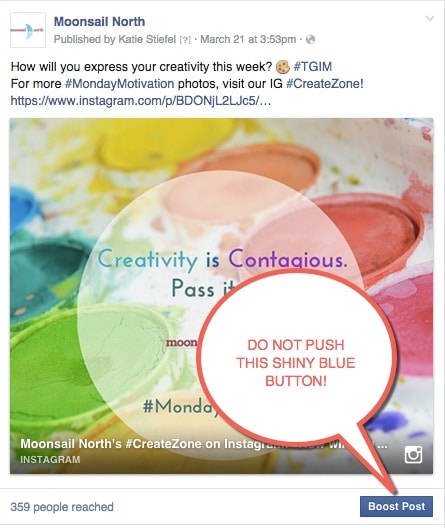As a millennial whose first career was as a reporter for a print newspaper, it’s been fascinating to watch the changes in the media landscape. All over the country, new and established media outlets continue to grapple with the best model — both the best business model for the organization’s fiscal health and the best model for maximizing readership, viewership and digital traffic.
It’s an impossibly tough job to run a media outlet. On the revenue side, newspaper ad revenue is still on the decline, for example. It’s at $19.9 billion now, which is less than half of what it was a decade ago, according to the Pew Research Center.
The Moonsail North team is invested in seeing quality journalism cut through the noise -– and we’ve had success making that happen. A few years ago, when Bridge Magazine was a young publication looking to find a larger audience of highly engaged readers, I planned and implemented a digital strategy that helped drive more than 1 million page views to their site. More recently, we’ve used targeted digital outreach to get the next generation of Pulitzer winners from across the country to sign up for the Connecticut Health Investigative Team’s annual summer journalism camp.
While I left the reporting life several years ago now, I’ve never forgotten the thrill of chasing down a big story. The same goes for Moonsail North’s co-founder, Rose, also worked as a journalist as a first career. We know the critical role that journalists play in a democracy, and we have great respect for those who work long hours to bring us the news.
Here are five digital and social media tips for news organizations to help get them started down the road of digital best practices. It gets increasingly complex from here, given that new challenges and opportunities, such as ad blocks and Facebook Instant Articles, crop up each quarter.
1) If you’re a nonprofit publication, apply for Google Ad Grants immediately.
This one is a no-brainer. Google Ad Grants is a program that provides $10,000 every month in free advertising to 501(c)(3)s through Google’s AdWords platform. Ad Grants allows you to create ads for your stories that show when people search for terms on Google. Say, for instance, you’re a California-based publication that just posted a big story on how conditions are improving for the state’s drought. By using Google Ad Grants, your stories can show up when people search for information about the drought.
Even better, this gives smaller nonprofits the ability to compete against larger, more established publications – which will almost certainly have more inbound links, meaning that their organic search ranking will likely be much higher.
If you’re a for-profit outlet, continue on to tip 2!
2) Set aside money for Facebook ads (it doesn’t have to be a lot)
You may have heard that Facebook is dying – but don’t believe the hype (not yet, anyway). According to an October 2015 story in Forbes, Facebook now accounts for more of the traffic to news sites than Google. 
We know that budgets are tight – and that’s especially true in the news industry, where cutbacks are all too commonplace, sadly.
But most of us can set aside a few dollars each week to drive people to our stories. The good news is, it doesn’t take a lot! Thanks to Facebook’s advanced targeting options, you don’t need to break the bank to reach your intended audience. Even $50 a month can make a big difference.
One additional note: I know it’s tempting to push that big blue “Boost Post” button and call it good. Resist the urge! Take the time to use Facebook’s Ad Manager instead. You’ll have more control over your creative and targeting options.
3) Facebook Live is the future
Facebook Live lets you stream live video through your mobile app, much like Meerkat or Periscope. The difference, of course, is that your video is pushed into the streams of your Facebook fans – who even receive a notification when you’re broadcasting! This is great for covering news conferences, but you can find other creative ways to use it – for example, maybe your reporters can have a roundtable discussion to analyze the election.
One other massive benefit – Facebook recently updated its infamous algorithm to give preference to live video.
4) Get your reporters trained
Your reporters are your best brand ambassadors – your audience will trust them as individuals more than they will trust the publication as an institution. They don’t need to be social media experts, but they should feel comfortable navigating the waters and engaging with readers, especially on Twitter. Bringing in outside experts to provide a social media boot camp could be beneficial – particularly for reporters who aren’t digital natives.
Your reporters are your best brand ambassadors – your audience will trust them as individuals more than they will trust the publication as an institution.
5) Twitter is vital for breaking news
If you pay close attention to your analytics, you may be disheartened to see that Twitter produces less traffic than you’d expect. Don’t be. Not only is Twitter integral for increasing your online reach and presence, it’s also vital for driving readers to your site during big unfolding events. When the Edward Snowden story broke in 2013, it was Twitter that drove the most traffic to the Guardian’s site. When news is happening faster than reporters can write stories, Twitter is the place to be.
The digital transition of the news industry has not always been a smooth one. But on the plus side, there’s a lot of great reporting out there desperate for eyeballs. More than ever, we need the fourth estate to be strong and successful – so make sure you’re properly using all the digital tools at your disposal.

